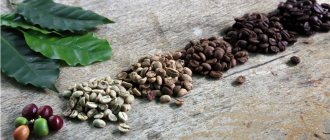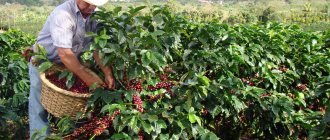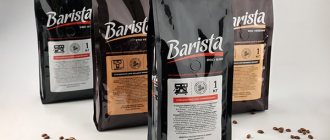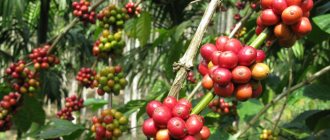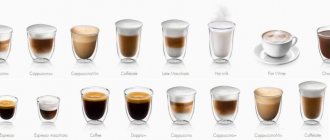More than 40 species of coffee trees grow in nature. But only two of them are usually used to produce coffee - Arabica and Robusta. Drinks made from them differ in smell and taste. Everyone will feel it. But only coffee lovers will determine what is poured in each cup. Let's find out how Arabica differs from Robusta and what it is.
Coffee: types, varieties
Arabica and robusta are species of coffee trees that are sometimes mistakenly called cultivars. Let's find out what the difference between these concepts is.
Coffee species are a group of coffee trees that have similar characteristics. Examples are: arabica, robusta, liberica (read “liberica”).
A coffee variety is a set of coffee plants bred through selection and possessing a set of certain characteristics that distinguish them from plants of the same species. Arabica varieties: mocha, typica, bourbon. Examples of Robusta varieties: Nanu, Kuilu, Java Ineak.
Arabica has a richer taste
Yes, it’s “richer” and not “tastier”, because everyone’s tastes are completely different, and we consider it wrong to say that one product is tastier than another. The versatility and intensity of the taste of Arabica, as well as the presence of the legendary sourness, is explained by the high content of lipids and sugars, and the diversity of terroirs of varieties of this type allows you to obtain many flavor shades.
Robusta coffee's low lipid content, coupled with a high caffeine content, turns the finished drink into a good energy drink, with a simple and clear taste, good body density, characteristic bitterness and lack of sourness.
Depending on the variety and country of origin, Robusta can taste quite different, and if you want to taste the differences between the varieties, just try buying a couple of Robusta coffees from our catalog.
What are the differences?
There are the following differences between Arabica and Robusta:
- shape, size, color of coffee bean;
- growing conditions;
- tree height;
- genetic code of plants;
- chemical composition of coffee beans;
- difficulty in growing crops;
- cost of coffee beans;
- taste qualities of drinks;
- application area;
- popularity in the world.
To better understand how Arabica differs from Robusta, let's talk about each of these differences in more detail.
Robusta
The Latin name for canephora is a type of Congolese coffee commonly known as robusta (strong). The plant is indeed more unpretentious compared to its Arabian counterpart. Disease-resistant, productive, able to grow in conditions where Arabica cannot survive. But, despite the low cost, sales of robusta account for only 20% of world coffee production. This is a very significant difference between Robusta and Arabica.
Congolese coffee trees can reach 10 meters in height. But individual subspecies can also be shrubs. They grow on plains or in foothill areas and are convenient for cultivation. Bicolor inflorescences are fragrant. The fruits ripen two months longer than Arabica, but the plants are more productive. The grains are round in shape, paired, with a diameter of no more than 5 mm.
You might be wondering: What is the difference between a Latte and a Cappuccino?
Connoisseurs and experienced tasters rate the quality of Robusta beans lower than that of Arabica. But twice the caffeine content provides a powerful, rich aroma and taste. Italian coffee culture loves to use this property, giving a strong aroma to blends. Robusta is more commonly found in instant coffee.
Popular plant varieties:
- Ambry. Grown in Angola. There are excellent conditions for cultivating these plants. The best varieties of Robusta are here.
- Conillon du Brasil comes from Brazil. It features harsh, earthy tones.
- Quilu. Grows in Congo. There is little presence on the market, but the quality is always high. Included in expensive mixtures.
The beans contain 8% aromatic oils, caffeine content can reach up to 3%. The alkaloid causes the bitter taste of varieties. When roasted, the bitterness and harshness softens. Espresso blends with high-quality Robusta beans produce a rich, stable foam.
The two most popular coffee beans differ in size.
Producing countries
Arabica is produced in the following countries:
- Brazil;
- Guatemala;
- India;
- Indonesia;
- Mexico;
- etc.
Robusta grows in Indonesia, Brazil, India, and also in Central African countries. Its share of the world coffee market is 25 percent. The share of arabica coffee beans is respectively 75 percent.
How to choose bean coffee with minimal acidity
A drink made from Arabica varieties that are not grown in the highlands will have the least sourness. Indeed, many people recognize this type as the standard of the best coffee. The following varieties also have a minimum amount of acid:
- Brazil Santos, grains do not grow in the highlands;
- India: Malabar Monsoon, which is processed by the Unwashed method;
- Nepalese, almost all grains contain only a small degree of acid.
Taste and aroma
Robusta and Arabica have differences in taste. The first one is very bitter, almost not sour. The drink made from it is stronger and rougher than its analogue. The exception is Indian robusta, the taste of which includes nutty and chocolate notes.
Arabica gives a specific sourness. It is sour, but not bitter. Depending on the variety, location, growing conditions of trees, processing of grains, you can get a wide variety of tastes. Examples:
- Brazilian arabica has a simple taste, devoid of bright shades;
- Mysore (India) is distinguished by the presence of wine sourness, which Indian Robusta lacks;
- Yemeni reveals notes of chocolate in its taste;
- Zambian combines light bitterness, sourness, and fruity flavor;
- Guatemalan - sour variety with a berry aftertaste, notes of bergamot and lemongrass.
Due to the wide variety of tastes, it is believed that Arabica coffee tastes better.
Varieties
The most popular varieties include the following:
- Bourbon Santos, one of the elite Brazilian varieties. For its production, grains are taken only from the first three years of harvest;
- Maragogyp, which is native to South America;
- Bali Shizan, with an unusual taste that combines cloves, persimmon and Jamaican pepper;
- Typica grows in Latin America and is one of the most expensive varieties. The fact is that it is grown only in the highlands and has a small yield;
- Catura, which is a Brazilian hybrid of very high quality;
- Venezuelan Caracas, attracting with its original smell;
- A plantation considered an Indian variety and characterized by a bitter chocolate taste and aroma that combines a whole bouquet of spices.
Each of these varieties has its own specific characteristics. But, at the same time, they all have a characteristic sweetish taste with a slight sourness.
Grain size and appearance
Another difference between Arabica and Robusta is external qualities (size, color, shape of grains). The following description will help you distinguish them:
- Arabica. It looks like an oval in shape. Size - 7–8 mm. After roasting they acquire a uniform brown color.
- Robusta. The shape resembles a circle. Size - less than 5–6 mm. The color does not become uniform after roasting. Its surface may include several shades of brown.
A photo will help you distinguish Arabica beans from cheaper counterparts. Look at the picture: one grain is elongated and large, the other is rounded and small.
Coffee trees
The Arabica coffee tree grows high in the mountains. Therefore, it grows only up to 4.5 m, less often - up to 5 m. Due to low air temperature and lack of moisture, this tree cannot achieve greater growth.
Robusta grows in places where the soil is rich in nutrients and moisture. In favorable conditions, the plant can reach a height of up to 10–12 m. But more often, tree trunks grow up to 6–7 m.
What a delicious coffee
Thus, we can summarize that if you drink coffee only as a tonic drink, then your choice is Robusta. However, if you are a connoisseur of the noble taste and aroma of an ancient drink, then you will not find anything better than pure Arabica varieties.
Therefore, to the question of what kind of coffee is delicious, the answer will be: coffee made from Arabica varieties.
This is also interesting:
- White coffee. What it is? White coffee is ordinary coffee beans lightly roasted in palm oil. There is also a name – “Ipoh coffee”, because... It is believed that roasting coffee beans this way [...]
- How to choose bean coffee The taste of coffee depends on the recipe and the type of coffee bean. True connoisseurs of this ancient drink distinguish such flavor and aromatic shades as: astringency, bitterness, […]
- Arabica coffee Arabica coffee is considered the main variety of coffee - it is grown a lot, approximately 70% of the total amount of coffee produced. Arabica tree (Coffea arabica) at an altitude of more than 1000m above […]
- Robusta Coffee Robusta is the second most common coffee variety. In terms of taste and aroma qualities, Robusta coffee is noticeably inferior to Arabica. The taste of Robusta is rougher and more specific. Coffee beans […]
Chemical composition of grains
The chemical composition of grains is determined by their species. It determines the taste, aroma, benefits and harms of a coffee drink.
Arabica beans contain half the caffeine content. This reduces their tonic properties. They contain more sucrose and less chlorogenic acid.
The drink brewed from them has a soft, rich, pleasant taste. It also contains more esters that determine aromatic properties. Therefore, this coffee has a rich aroma.
The table will clearly demonstrate the differences in the composition of natural coffee of both varieties.
| Component | Arabica | Robusta |
| Ethers | 18% | 8% |
| Sugar | 8% | 4% |
| Chlorogenic acid | 6,5% | 9% |
| Caffeine | 1–1,5% | 3% |
What's better
It is impossible to answer this question unambiguously. This is a matter of taste preference. To brew, you need to follow the recipe - errors in it negatively affect the quality of coffee.
Remember that a high-quality drink can only be brewed from high-grade grains, and it doesn’t matter what type they are. Each of them has fans. Some people like light sourness, others like strong bitterness.
Therefore, when choosing which is better - Arabica or Robusta - it is recommended to focus on personal taste preferences.
To obtain an interesting coffee flavor, it is recommended to combine both varieties.
Once you have made your choice, do not forget to invite your friends for a cup of a tonic, invigorating drink, brewed with love.
Genetic differences
All species of living organisms have their own unique genetic code. For trees of the genus Coffea, this rule is no exception, because their representatives differ in some characteristics and characteristics.
Robusta coffee has 22 chromosomes, Arabica coffee has 44.
This explains the variety of flavor and aromatic qualities of the latter. Each gene forms a specific trait. The more genes, the higher the species variability, the more varieties breeders can develop
Features of cultivation
The growing altitude of Arabica coffee is 600–2200 m above sea level. Plants grow on a mountain landscape. The optimal air temperature for them is +15…+24 °C. For successful cultivation, 1200–2000 mm of precipitation is required per year.
Robusta is a tree that prefers to grow on flat terrain, rising up to 800 m above sea level. It is more demanding of heat and moisture. The optimal temperature is +18…36 °C, the annual precipitation level is 2000–3000 mm.
Despite the apparent unpretentiousness of arabica coffee trees, they are more difficult to cultivate. They are more susceptible to parasites, bacterial, viral, and fungal diseases. This is due to the fact that this type of coffee contains the least amount of caffeine, which prevents plants from being damaged by pests and infections.
Areas, purposes of application
The two most popular types of coffee also differ in the purposes people have found for them. There is a big difference in the fruits of which tree are the basis of the drink.
Coffee Arabica is usually used 100 percent pure, as it has high taste and aromatic qualities. Robusta in its pure form is rarely used, mainly for preparing a powerful invigorating espresso drink. Most often used to prepare coffee mixture.
You can find blended coffee in stores. Not everyone knows what a blend is. This is the name given to a mixture of two types of coffee.
The ratio of Arabica and Robusta in the blend can be different: 10%/90%, 20%/80%, 50%/50%.
Arabica usually predominates in a natural coffee blend. If there is little of it, it does not have a significant effect on the flavor and aroma properties. In inexpensive instant forms of drinks, robusta occupies a large share.
Best Arabica coffee beans 2021
As you already understand, Robusta is for real coffee lovers. If you want something softer and more pleasant to taste, then this is definitely 100% Arabica.
And here are the highest quality products of this variety available in Russia:
- Cafecom Galapagos Gourmet. Rare Ecuadorian coffee with a slight sourness and rich taste with pronounced notes of citrus, mountain plants and spices. Suitable for almost any type of brewing.
- Lavazza Qualita Oro. The best collection of coffee with a very rich sweetish taste and intense malt-honey aroma. A slight sourness is felt. Medium roast and medium grind make this coffee versatile for any preparation method.
Lavazza is one of the best coffee producers in Italy and in the world
- Blue Mountain. An elite variety of Jamaican coffee in original packaging with an air release valve. The taste is very subtle, nutty and fruity, soft, without bitterness. Refers to strong brands.
- Lavazza Caffe Espresso. A combined product from Arabica beans from different regions, with a rich taste and aroma. The degree of roasting is light, the strength is also medium, 5 out of 10.
What could be better than an invigorating cup of espresso with foam in the morning?
- Jardin Cuin Dessp. Arabica beans roasted using Thermo Two technology. Created on the basis of a blend of two types of Arabica - from Africa and Central America. It has a rich dessert taste and aroma with a light, noble sourness. The advantage of this coffee is also its affordable price.
Popularity in the world
It is interesting to know which coffee is more popular. Arabica accounts for 70–75% of the volume of coffee produced. It is more popular among lovers of a natural drink, which is brewed using a kettle.
Can you guess which coffee is more popular for the production of instant drinks? The main purpose of a soluble analogue of grains is to enable people to cheer up inexpensively in the morning. Therefore, most manufacturers use robusta or a mixture in which the proportion of its content is maximum for its production.
Why is it better to choose a mixture of Arabica and Robusta?
Today, an increasing number of manufacturers offer their potential buyers mixed products from these two varieties, which has its own explanation.
What is the secret of popularity
Today, there are more and more coffee brands in which Arabica is mixed with Robusta in proportions of 70/30 and 80/20. Of course, first of all, this is done for reasons of economy, since the price of pure Arabica coffee is often painful.
However, there are other reasons for mixing.
Among them is the ideal balance of strength and taste, which can only be maintained by combining these two varieties. Simply put, they are perfect companions for each other, especially if you stick to the above percentages.
